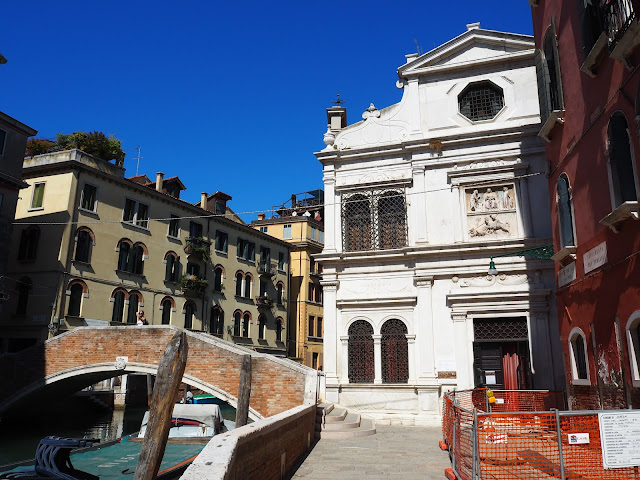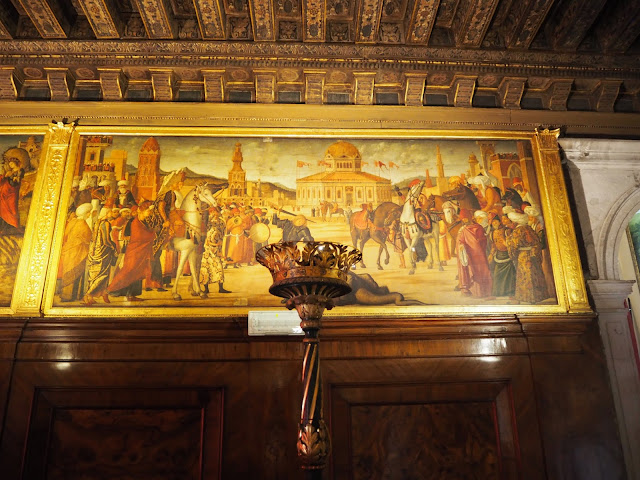【ヴェネツィア】スクオーラ・ダルマータ・サン・ジョルジョ・デッリ・スキアヴォーニ Venezia - Scuola di San Giorgio degli Schiavoni
ドゥカーレ宮殿の前から、海沿いに東にしばらく歩いて、左手に曲がっていくと、スクオーラ・ダルマータ・サン・ジョルジョ・デッリ・スキアヴォーニがある。
スクオーラとは、英語で言えばスクール。本来は学校や同業者組合という意味だが、ヴェネツィアでは同じ守護聖人を敬う人々が集まった組織のことを言う。日本語では、同信組合と言う名前があてられている。
このスクオーラは、名前にダルマータ、ダルマチア地方と、サン・ジョルジュ、聖ゲオルギウスと言う言葉があるので、聖ゲオルギウスを守護聖人とするダルマチア地方の人々の同信組合、ということになるのだろう。
現在はクロアチアの一部になっているダルマチア地方は、良港に恵まれた土地で塩の産地でもあり、ヴェネツィア共和国にとっては大事な地域だった。
中でも世界遺産にも登録されている、ドゥブロヴニクという町は観光地としても有名だ。
そうした関係から、ヴェネツィアにも多くのダルマチア地方の出身者が暮らしていたのだろう。
From the front of the Doge's Palace, walk east along the sea for a while and turn left to find Squala Darmata San Giorgio delli Schiavoni.
Squala is a school in English. Originally meant as a school or trade union, in Venice it is an organization of people who respect the same patron saint. In Japanese, the name is Doshinkai.
This squaora has the words Dalmatia and Dalmatia, and Saint George and St. George, so it may be a fellowship of the people of Dalmatia who have St. George as their patron saint.
The Dalmatian region, which is now part of Croatia, is a land blessed with good ports and a salt-producing region, and was an important region for the Republic of Venice.
Among them, the town of Dubrovnik, which is registered as a World Heritage Site, is also famous as a tourist destination.
Because of this relationship, many people from the Dalmatian region probably lived in Venice as well.
このスクオーラは、カルパッチョによる様々な聖人たちの逸話を描いた絵画があることで知られている。
中でも、聖ギオルギウスが槍で竜に挑みかかっている絵画はとりわけ有名だ。
聖ギオルギウスは、カッパドキア生まれと言われ、リュビアの地を訪れた際に毎日竜に生贄を捧げて苦しんでいる住民のために竜を退治した。
日本の素戔嗚尊の八岐大蛇伝説と同じような話だが、竜退治の伝説は世界中の神話や物語に残っている。
この聖ギオルギウスの竜退治の話は西洋芸術の歴史の中で繰り返し描かれてきたテーマで、カルパチョの他にも、ウッチェロ、アングル、ルソー、バーン=ジョーンズら様々な画家たちが描いている。
This squala is known for its paintings by Carpaccio depicting the anecdotes of various saints.
Among them, the painting in which St. George is challenging the dragon with a spear is especially famous.
St. George, who is said to have been born in Cappadocia, exterminates dragons for the suffering inhabitants who sacrifice them every day when they visit the land of Lubia.
It's a story similar to the legend of Yamata no Orochi in Japan, but the legend of dragon extermination remains in myths and stories all over the world.
This story of St. George's dragon extermination is a theme that has been repeatedly drawn in the history of Western art, and in addition to Carpacho, various painters such as Uccello, Angle, Rousseau, and Burne-Jones have drawn it.
この作品では、聖ギオルギウスが退治した竜を王の所に連れてきて、とどめを刺す様子が描かれている。
カルパッチョの生涯は、よくわかっていないことが多いらしいが、1460年頃に生まれて、1525年頃に亡くなったと言われている。
同じ時代にはヴェネツィア派絵画の祖ともいえるベッリーニ兄弟がいるが、その兄のジェンティーレ・ベッリーニに師事していたという。
In this work, St. George brings the defeated dragon to the king and stabs the end.
Carpaccio's life is often unknown, but it is said that he was born around 1460 and died around 1525.
At the same time, there was the Bellini brothers, who can be said to be the ancestors of Venetian painting, but it is said that he studied under his brother Gentile Bellini.
聖ギオルギウスが、国王と王女を祝福して大団円といった場面だろうか。
カルパッチョは、風景の中に多くの人々を細かく描くのが得意だったようだ。
背景の建物の窓や、風にたなびいている旗、そして人々のまとっている洋服の細かい模様などが、実に丹念に書き込まれている。
それは、師事したジェンティーレ・ベッリーニの得意な分野でもあったのだろうが、カルパッチョの作品にはジェンティーレにはない、独特の世界観がある。
Is it a scene where St. George congratulates the king and princess and makes a big circle?
Carpaccio seems to have been good at drawing many people in detail in the landscape.
The windows of the building in the background, the flags fluttering in the wind, and the detailed patterns of the clothes worn by the people are written with great care.
It may have been a specialty of Gentile Bellini, who studied, but Carpaccio's work has a unique world view that Gentile does not have.
この作品には、聖ヒエロニムスの逸話が描かれている。聖ヒエロニムスはダルマチア生まれと言われているので、このスクオーラにはピッタリの聖人だ。
聖ヒエロニムスは、トゲが刺さって痛がっていたライオンのトゲを抜いてあげたという逸話が残っている。
この作品には、トゲを抜いてもらったライオンが聖ヒエロニムスになつているの様子に、周囲の修道士の人々が驚いて逃げ回っている、というユニークなシーンが描かれている。
This work depicts an anecdote of St. Jerome. St. Jerome is said to have been born in Dalmatia, so he is a perfect saint for this squaora.
There is an anecdote that St. Jerome pulled out the thorns of a lion that had been stabbed and hurt.
In this work, a unique scene is depicted in which the lion who had the thorns pulled out is becoming St. Jerome, and the surrounding monks are surprised and running away.
こちらは、葡萄の守護聖人、聖トリフォンの逸話が描かれている。
他にも何点か作品があったが、カルパッチョはこれらの絵画を1502年から10年ほどかけて完成させたようだ。
フランスの哲学者、ミシェル・セールは、このスクオーラを訪れてカルパッチョの作品が好きになり、後に『カルパッチョ 美学的探究』という本を書いている。
その中には『竜と戦うゲオルギウス』という1章も設けられている。
セールはその中で、”この絵は一つのプロブレムではなく、幾つもの解法のエンブレムである。”という独特な表現でこの絵を特徴つけて、様々なテーマをこの絵から読み解いている。
This is an anecdote of St. Triphon, the patron saint of grapes.
There were several other works, but Carpaccio seems to have completed these paintings in 1502 to 10 years.
French philosopher Michel Serres visited this squara and became fond of Carpaccio's work, and later wrote a book called "Carpaccio Aesthetic Exploration".
There is also a chapter called "Georgius Fighting the Dragon".
In it, Sale characterizes this painting with a unique expression, "This painting is not a single problem, but an emblem of several solutions." He interprets various themes from this painting.
(Translated by Google Translate)








コメント
コメントを投稿